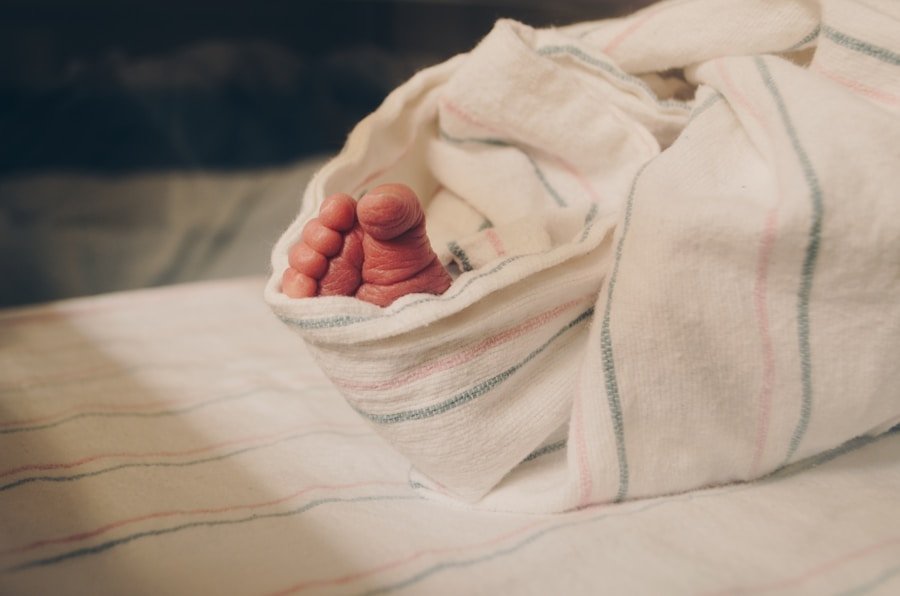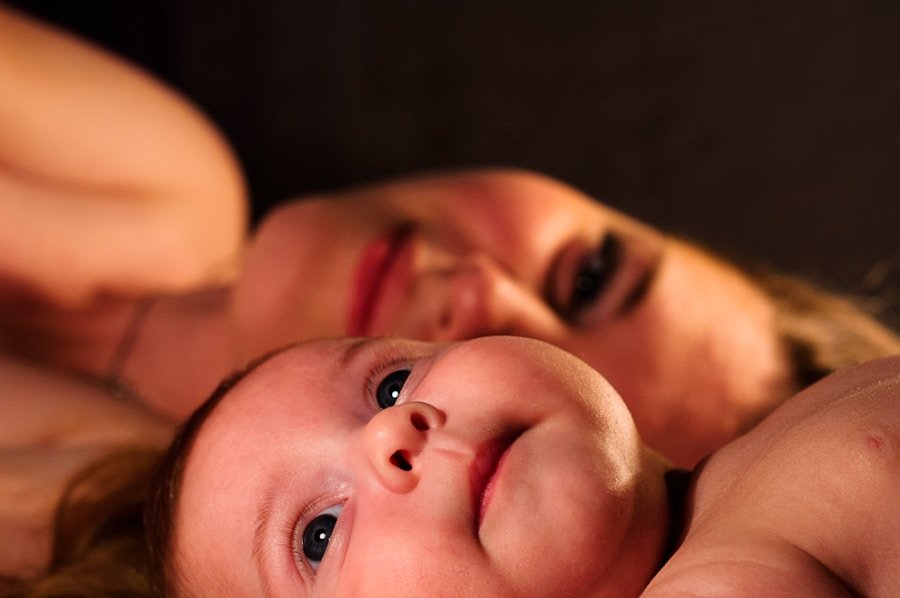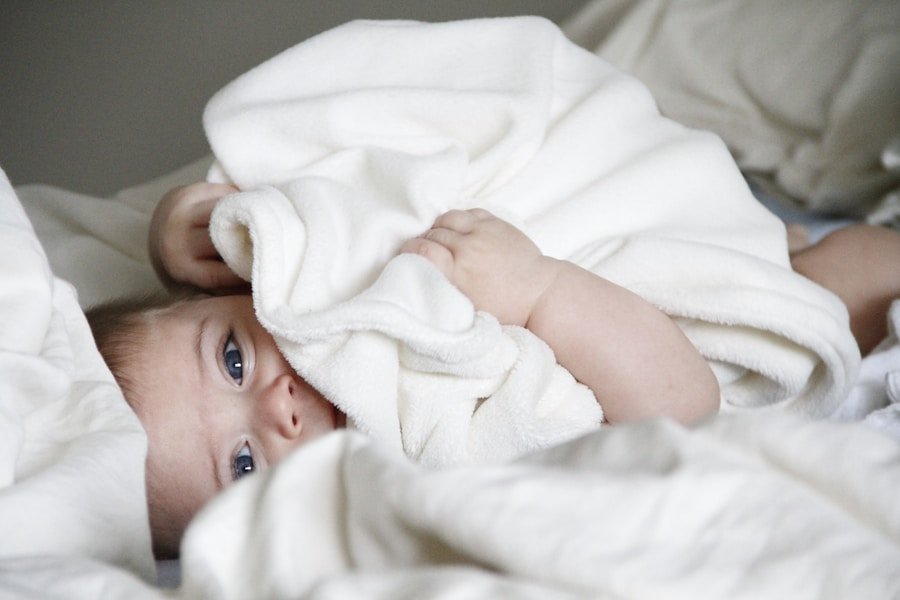Swaddling is the practice of wrapping a newborn snugly in a blanket or cloth to provide them with a sense of security and comfort. This age-old tradition has been used by parents around the world for centuries, and for good reason. Swaddling helps to mimic the feeling of being in the womb, which can soothe and calm a newborn, making them feel safe and secure in their new environment.
This can be especially helpful in the first few months of a baby’s life when they are adjusting to the outside world and may be experiencing discomfort from gas, colic, or startle reflexes. Swaddling can also help to regulate a baby’s body temperature and prevent them from scratching their face with their sharp little nails. Swaddling is important for newborns because it can help them to feel more secure and comfortable, which can lead to better sleep and overall well-being.
It can also help to reduce the risk of Sudden Infant Death Syndrome (SIDS) by keeping a baby on their back while they sleep and preventing them from rolling onto their stomach. Additionally, swaddling can help to soothe a fussy baby and make it easier for parents to calm and comfort their little one. Overall, swaddling is an important practice for newborns that can provide numerous benefits for both the baby and their parents.
Key Takeaways
- Swaddles are snug blankets that help newborns feel secure and comfortable, mimicking the feeling of being in the womb.
- Swaddling can help newborns sleep better by preventing the startle reflex and promoting a sense of security.
- There are different swaddling techniques, such as the diamond, square, and the hands-over-heart, to ensure a snug and safe swaddle for newborns.
- When choosing a swaddle, consider the material, size, and ease of use to ensure it is comfortable and safe for your baby.
- Safety tips for swaddling include ensuring the swaddle is not too tight, keeping the baby’s head uncovered, and stopping swaddling once the baby starts to roll over.
The Benefits of Swaddling for Newborns
Swaddling offers numerous benefits for newborns, including improved sleep, reduced crying, and a decreased risk of SIDS. When a baby is swaddled, they are less likely to startle themselves awake with their own movements, which can help them to sleep longer and more soundly. This can be especially helpful for parents who are struggling with a fussy or colicky baby who has trouble settling down to sleep.
Swaddling can also help to reduce crying by providing a sense of security and comfort for the baby, which can help to soothe them when they are feeling upset or overwhelmed. In addition to these benefits, swaddling can also help to regulate a baby’s body temperature, which is important for their overall health and well-being. Newborns have a hard time regulating their body temperature on their own, so swaddling can help to keep them warm and cozy without overheating.
This can be especially helpful in colder climates or during the winter months when it is important to keep a baby warm and comfortable. Overall, the benefits of swaddling for newborns are numerous and can have a positive impact on both the baby and their parents.
How Swaddling Helps Newborns Sleep
Swaddling can be incredibly helpful in promoting better sleep for newborns. When a baby is swaddled, they are less likely to startle themselves awake with their own movements, which can help them to sleep longer and more soundly. This can be especially helpful for parents who are struggling with a fussy or colicky baby who has trouble settling down to sleep.
Swaddling can also help to reduce crying by providing a sense of security and comfort for the baby, which can help to soothe them when they are feeling upset or overwhelmed. In addition to these benefits, swaddling can also help to regulate a baby’s body temperature, which is important for their overall health and well-being. Newborns have a hard time regulating their body temperature on their own, so swaddling can help to keep them warm and cozy without overheating.
This can be especially helpful in colder climates or during the winter months when it is important to keep a baby warm and comfortable. Overall, the benefits of swaddling for newborns are numerous and can have a positive impact on both the baby and their parents.
Swaddling Techniques for Newborns
| Swaddle Benefits | Explanation |
|---|---|
| Helps newborns sleep better | Swaddling can mimic the feeling of being in the womb, helping newborns feel secure and sleep more soundly. |
| Reduces startle reflex | Swaddling can prevent newborns from waking themselves up due to their startle reflex, allowing for longer periods of sleep. |
| Calms fussy babies | The gentle pressure of a swaddle can help soothe newborns and reduce fussiness. |
| Regulates body temperature | Swaddling can help newborns maintain a comfortable body temperature, preventing them from getting too cold or too hot. |
There are several different techniques for swaddling a newborn, but the most important thing is to make sure that the swaddle is snug but not too tight. The first step is to lay a blanket or cloth flat on a surface with one corner folded down. Then, place the baby on their back with their head above the folded corner.
Next, bring one corner of the blanket across the baby’s body and tuck it underneath them, making sure that their arms are straight at their sides. Then, bring the bottom corner up over the baby’s feet and tuck it under their chin, making sure that it is not too tight around their neck. Another popular swaddling technique is the “diamond” or “angel” swaddle, which involves folding the blanket into a diamond shape before wrapping it around the baby.
This technique can be especially helpful for keeping the swaddle secure and preventing it from coming undone while the baby sleeps. Whichever technique you choose, it is important to make sure that the swaddle is snug but not too tight, as this can restrict the baby’s movement and lead to discomfort or injury.
Choosing the Right Swaddle for Your Baby
When it comes to choosing the right swaddle for your baby, there are several factors to consider. The first thing to think about is the material of the swaddle, as it should be soft and breathable to keep your baby comfortable and prevent overheating. Many parents prefer to use muslin or cotton blankets for swaddling, as these materials are gentle on a baby’s delicate skin and allow for airflow.
It is also important to consider the size of the swaddle, as it should be large enough to wrap around your baby securely without being too bulky or restrictive. Another important factor to consider when choosing a swaddle is the design and closure method. Some swaddles come with Velcro or snaps to make it easier to secure the blanket around your baby, while others require you to fold and tuck the blanket yourself.
It is important to choose a swaddle that you feel comfortable using and that will stay secure while your baby sleeps. Additionally, some swaddles come with features like adjustable wings or leg pouches to accommodate different sleeping positions and prevent hip dysplasia. Overall, choosing the right swaddle for your baby is an important decision that can have a big impact on their comfort and safety.
Safety Tips for Swaddling Newborns
While swaddling can be incredibly beneficial for newborns, it is important to follow some safety guidelines to ensure that your baby is swaddled properly and safely. The first thing to keep in mind is that a swaddle should never be too tight or restrictive, as this can lead to discomfort or injury for your baby. It is important to make sure that your baby’s hips have room to move and that they are not wrapped too tightly around their chest or neck.
Another important safety tip for swaddling newborns is to make sure that your baby is placed on their back while they sleep. This can help to reduce the risk of Sudden Infant Death Syndrome (SIDS) by keeping your baby in a safe sleeping position. It is also important to make sure that your baby’s head is uncovered while they sleep, as this can help to prevent overheating and reduce the risk of suffocation.
Additionally, it is important to stop swaddling your baby once they start showing signs of rolling over on their own, as this can increase the risk of injury.
The Importance of Swaddling for Newborn Development
Swaddling plays an important role in newborn development by providing babies with a sense of security and comfort during their first few months of life. This can help them to feel safe and calm in their new environment, which can have a positive impact on their overall well-being. Swaddling can also help babies to sleep better and longer, which is important for their growth and development.
When babies are able to get enough rest, they are better able to focus and learn new skills, which can have long-term benefits for their development. In addition to these benefits, swaddling can also help babies to regulate their body temperature and prevent them from scratching their face with their sharp little nails. This can help babies to stay comfortable and healthy as they adjust to life outside of the womb.
Overall, swaddling plays an important role in newborn development by providing babies with the comfort and security they need to thrive in their first few months of life.
Alternatives to Swaddling for Newborn Comfort
While swaddling can be incredibly beneficial for newborns, it may not be the right choice for every baby. Some babies may not enjoy being swaddled or may have difficulty settling down while wrapped in a blanket. In these cases, there are several alternatives to swaddling that can provide comfort and security for newborns.
One popular alternative is using a sleep sack or wearable blanket, which allows babies to move their arms and legs while still feeling cozy and secure. Another alternative to swaddling is using a baby wrap or carrier, which allows parents to hold their baby close while keeping their hands free. This can provide babies with a sense of security and comfort while allowing them to move freely and explore their surroundings.
Additionally, some babies may find comfort in being held or rocked by their parents, which can provide them with the security they need without being wrapped in a blanket. Overall, there are several alternatives to swaddling that can provide comfort and security for newborns who may not enjoy being wrapped in a blanket. In conclusion, swaddling is an important practice for newborns that provides numerous benefits for both the baby and their parents.
It helps babies feel secure and comfortable, promotes better sleep, regulates body temperature, reduces crying, and decreases the risk of SIDS. There are various techniques for swaddling newborns, but it’s essential to ensure that the swaddle is snug but not too tight. When choosing a swaddle, consider factors such as material, size, design, and closure method.
Safety tips include ensuring that the swaddle isn’t too tight or restrictive, placing the baby on their back while sleeping, keeping their head uncovered, and stopping swaddling once they start rolling over on their own. Swaddling plays an essential role in newborn development by providing babies with comfort and security during their first few months of life. However, if a baby doesn’t enjoy being swaddled, there are alternatives such as sleep sacks, wearable blankets, baby wraps or carriers, or being held or rocked by parents.
Ultimately, whether you choose to swaddle your newborn or explore alternative methods of comfort, it’s essential to prioritize your baby’s safety and well-being while providing them with the security they need during this crucial stage of development.
FAQs
What is a swaddle?
A swaddle is a cloth or blanket that is used to wrap a newborn baby snugly, providing a sense of security and comfort.
Why are swaddles important for newborns?
Swaddles are important for newborns because they mimic the feeling of being in the womb, which can help soothe and calm the baby. Swaddling can also help prevent the startle reflex, which can disrupt a baby’s sleep.
How do swaddles benefit newborns?
Swaddles can benefit newborns by promoting better sleep, reducing the risk of Sudden Infant Death Syndrome (SIDS), and providing a sense of security and comfort for the baby.
When should swaddling be stopped?
Swaddling should be stopped once the baby starts showing signs of rolling over, usually around 2-3 months of age. At this point, swaddling can increase the risk of suffocation or injury.






































